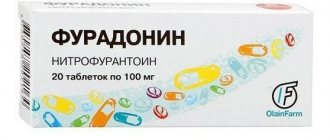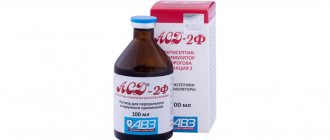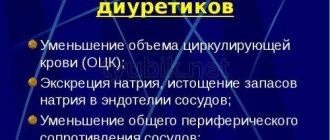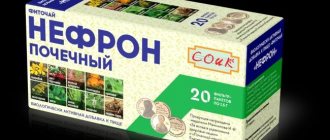Pharmacodynamics and pharmacokinetics
This substance inhibits the processes of synthesis of deoxyribonucleic and ribonucleic acids , proteins, reduces membrane permeability and the intensity of aerobic metabolism of harmful bacteria. The medicine has a wide spectrum of action, the drug is effective against gram-negative or gram-positive bacteria . The drug inhibits the vital functions of: streptococci , staphylococci , Shigella dysenteriae , Shigella boydii , Escherichia coli , Shigella flexneri , Shigella sonnei , Proteus spp .
The medicine has a high absorption capacity. After penetration of the substance into the gastrointestinal tract, the bioavailability of the product is about 50%. Eating increases the bioavailability of the substance. The smaller the crystals of a chemical compound, the better they dissolve and penetrate into the systemic bloodstream. The microcrystalline form is absorbed faster and reaches maximum concentration in urine in a shorter period of time. About 60% binds to blood plasma proteins. The substance undergoes metabolism in the liver and muscle tissues. The half-life is 20 to 25 minutes.
The drug crosses the blood-brain barrier, penetrates the placenta, and is excreted in breast milk. The drug does not accumulate in the body and is completely eliminated by the kidneys, about 40% unchanged.
Furolin instructions for use
Instructions
Nitrofurantoin is an antibacterial drug with an antiseptic effect. The antibiotic is used in the treatment of diseases caused by pathogenic bacteria entering the urinary system.
Nitrofurantoin is an antibacterial drug with an antiseptic effect.
Name
Same as the name of the drug.
Chemical name
1-[[(5-Nitro-2-furanyl)methylene]amino]-2,4-imidazolidinedione.
Release form and composition
The tablets are flat and round in shape and yellow in color.
Active ingredients: nitrofurantoin compounds, potato starch, colloidal silicon dioxide, calcium stearate. The amount of active ingredient in tablets intended for persons over 18 years of age is 50 mg and 100 mg, the drug for children under 12 years of age is 30 mg.
The tablets are flat and round in shape and yellow in color.
Spectrum of action of Nitrofurantoin
Affects most bacteria that cause urinary tract infections: Escherichia coli, staphylococci, streptococci and shigella (Shigella flexneri, Shigella boydii, Shigella sonnei, Proteus spp., Staphylococcus spp., Escherichia coli, Klebsiella spp., Enterobacter spp.).
pharmachologic effect
Furadonin is a synthetic antimicrobial agent.
Mechanism of action
Antibacterial properties are achieved by disrupting the process of nucleic acid synthesis in cells and stopping the respiration of bacteria.
Pharmacodynamics
Furadonin produces highly reactive amino acid derivatives that partially or completely stop the process of biological activity of proteins in the ribosomes of pathogenic bacteria.
Metabolic processes in the cells of pathogenic microorganisms are suppressed. The drug penetrates the bacterial cell through membranes, disrupting the structure of DNA and RNA.
The destruction of bacteria is achieved by changing the protein structure of cells and inhibiting aerobic metabolism, which cannot occur without access to oxygen.
The drug penetrates the bacterial cell through membranes, disrupting the structure of DNA and RNA.
Pharmacokinetics
The medication is absorbed by the mucous membranes of the digestive system. The relationship with plasma proteins is 60%. The percentage of bioavailability is 50%. The main active compound takes part in the metabolic process occurring in the liver tissue.
Half-life occurs 20-30 minutes after taking the medication. The compound penetrates the placenta barrier and is absorbed into breast milk.
50% is excreted unchanged through the kidneys in the urine.
Indications for use of Nitrofurantoin
Infectious-inflammatory diseases of the urinary system:
- cystitis;
- pyelonephritis;
- pyelitis;
- urethritis.
Indications for the use of Nitrofurantoin are infectious and inflammatory diseases of the urinary system.
In case of chronic disease, take it as a prevention of relapse. An antibiotic is prescribed after surgery to prevent infections.
Method of administration and dosage of Nitrofurantoin
The drug is taken immediately after the main meal. The dosage is individual, the course of treatment is from 7 to 10 days.
Pills
Oral administration. After surgical interventions, the dosage is 200 mg per day, divided into 2 doses. Therapy lasts 3 days.
For cystitis
Acute infection - 100 mg 2 times a day. The course of treatment is 7 days. Chronic cystitis - 100 mg 4 times a day for 10 days.
For urethritis
Acute infection - from 200 to 400 mg per day, divided into 2 doses. Chronic urethritis - from 300 to 600 mg in 2 doses. Course - 7 days.
For pyelonephritis
Acute course of the disease - 150-200 mg twice a day. Therapy for chronic pyelonephritis - 600 mg per day, divided into 2-3 doses. The course of treatment is 1 week.
Use in children
The medication is prescribed to children in the age group 1 month - 12 years, only in cases where taking alternative medications does not provide the desired therapeutic effect.
The dosage is calculated according to the scheme 5-8 mg per kg of weight per day, divided into 4 doses.
To give the drug to children, you can use any sweet syrup, water, juice in which the crushed tablet is mixed.
The medication is prescribed to children in the age group 1 month - 12 years, only in cases where taking alternative medications does not provide the desired therapeutic effect.
Nervous system and sensory organs
Neuropathy of the peripheral system, frequent headaches, attacks of dizziness, insomnia, fever.
Respiratory system
Pain in the sternum, dry cough, development of broncho-obstructive syndrome. Rarely - changes in the structure of the lung tissue.
Gastrointestinal tract
Epigastric pain, diarrhea, development of pseudomembranous type colitis, biliary tract dysfunction, pancreatitis, hepatitis.
When taking Nitrofurantoin, unwanted side effects, such as diarrhea, may occur.
Allergic reactions
Rash and itching of the skin. Less commonly - aches and pain in muscles and joints, anaphylaxis.
Features of application
Furadonin should be taken with caution by people diagnosed with anemia, type 1 and 2 diabetes mellitus, and renal failure. In elderly patients, when taking the drug for a long time, it is necessary to monitor pulmonary function. The medication gives the urine a red or brown color.
In elderly patients, when taking the drug for a long time, it is necessary to monitor pulmonary function.
The medicine is not used in the treatment of prostatitis, diseases of the renal cortex and purulent paranephritis. Long-term use of an antibiotic can increase bacterial resistance, which will lead to a decrease in therapeutic effect. In the event of a sudden cessation of positive dynamics from taking the medication, another drug is selected for treatment.
During pregnancy and lactation
Pregnant and lactating women are strictly prohibited from taking antibiotics. If it is necessary to take it during lactation, the child should be temporarily transferred to artificial feeding.
At what age can children take the drug?
The permissible age of admission is from 1 month after birth, in cases where the positive effect outweighs the possible risks of complications.
Effect on concentration
Furadonin does not affect reaction speed and concentration. There are no restrictions on driving vehicles or operating complex machinery during the therapy period.
There are no restrictions on driving vehicles or operating complex machinery during the therapy period.
Drug interactions
It is prohibited to take fluoroquinolones simultaneously with medications.
With other drugs
Sulfinpyrazone and Probenecid - reduce secretion by the renal tubules, suppressing the antibacterial effect of Nitrofurantoin.
Concurrent use of nalidixic acid reduces the therapeutic effect.
Drugs that have a neurotoxic effect on the body increase the likelihood of developing side symptoms.
Medicines containing magnesium trisilicate slow down the absorption of Nitrofurantoin into the gastrointestinal tract.
Alcohol compatibility
It is strictly forbidden to consume alcoholic and alcohol-containing drinks during the treatment course. Alcohol has a diuretic effect, reducing the concentration of the active component Nitrofurantoin in the body. Taking alcohol with Nitrofurantoin increases the toxic effect of the drug on the liver, which can lead to the development of severe side symptoms.
It is strictly forbidden to consume alcoholic and alcohol-containing drinks during the treatment course.
Storage conditions and periods
At a temperature of no more than 25°C. Shelf life - 5 years.
Recipe in Latin
Rp.: Tab. Furadonini 0.1
DTD No. 30
S. indicates the dosage and frequency of administration per day.
Analogs
Nitrofurantoin has no analogues with similar structural parameters. If it is necessary to switch to taking other medications for the treatment of urinary system infections, medications similar in the spectrum of action to Furadonin are prescribed: Furamag, Furagin, Urofuragin.
Doctor's reviews about the drug Furadonin: indications, administration, course, side effects, analogues
Furamag, instructions for use. Infectious and inflammatory diseases
Doctor's reviews about the drug Furagin: indications, administration, side effects, analogues
Indications for use
The drug is prescribed:
- for the treatment of urinary tract infections caused by organisms sensitive to the active substance ( pyelitis , cystitis, urethritis, pyelonephritis );
- as a prophylactic agent during catheterization, cystoscopy and other urological studies and operations.
Contraindications
The medicine is contraindicated:
- with severe disturbances in kidney function;
- patients with chronic renal or heart failure stages 2 and 3;
- with oliguria ;
- pregnant women;
- with glucose-6-phosphate dehydrogenase ;
- children under 1 month;
- if allergic to the active substance;
- persons suffering from chronic hepatitis or cirrhosis of the liver ;
- for acute porphyria ;
- while breastfeeding.
Particular care must be taken in the presence of fibrotic changes in the lungs and in patients with bronchial asthma .
Side effects
After taking the pills you may experience:
- vomiting, dizziness , nausea, headaches;
- arthralgia , asthenia , myalgia , nystagmus , anaphylactic shock ;
- lupus-like syndrome , chills and skin rashes, eosinophilia ;
- drowsiness , cough, pain in the chest, broncho-obstructive syndrome , fever , interstitial changes in the lung tissue;
- hepatitis , pancreatitis , cholestatic syndrome , pseudomembranous enterocolitis , diarrhea ;
- peripheral neuropathy , abdominal pain.
With long-term treatment with the drug, the likelihood of developing malignant kidney tumors .
Nitrofurantoin, its derivatives and metabolites have a toxic effect on the lungs. One patient out of 5000 after completing a single course of the drug develops: shortness of breath , cough, fever , eosinophilia , myalgia and bronchospasm . Long-term treatment with the drug can lead to lobar infiltration , pleural exudation , vasculitis , alveolar exudation , interstitial inflammation .
In 1 in 20,000 patients, taking this substance causes pulmonary fibrosis and other irreversible toxic damage to lung tissue. If therapy is repeated, the risk of developing this type of damage increases significantly.
Allergic reactions that are observed during treatment with the drug disappear on their own after cessation of therapy.
Special instructions for the use of the drug Nitrofurantoin
Nitrofurantoin should be administered with caution to patients with impaired renal function, anemia, diabetes mellitus, electrolyte imbalance, B vitamin deficiency, or severe chronic illness due to the increased risk of developing peripheral neuropathy; Taking nitrofurantoin should be stopped immediately when the first symptoms of neuropathy appear. Nitrofurantoin should be used with caution in patients with glucose-6-phosphate dehydrogenase deficiency because hemolysis may occur in such patients; if it develops, you should immediately stop taking nitrofurantoin. During long-term treatment with nitrofurantoin, it is necessary to periodically monitor the composition of peripheral blood, the functional state of the kidneys and liver. The safety of nitrofurantoin during pregnancy and lactation has not been established.
Nitrofurantoin, instructions for use (Method and dosage)
Tablets are prescribed orally. The medicine must be taken with plenty of liquid.
Nitrofurantoin, instructions for use
Patients are prescribed from 50 to 150 mg of the drug in 3-4 doses per day. The course of treatment ranges from 5 days to one week.
The maximum single dosage for an adult is 0.3 grams of the drug. You can take up to 0.6 mg of medication per day.
Children are prescribed 5-8 mg of the substance per kg of weight. The daily dosage is divided into 4 doses.
If necessary, treatment can be continued for up to 10 days, provided that the sterility of the urine is monitored.
If there is a need for long-term maintenance treatment with the drug, it is better to use the minimum dosage. When carrying out therapy for 3 months or more, the optimal amount of Nitrofurantoin that the patient can take per day is 1.5 mg per kg of weight.
Furadonin
Name: Furadonin Pharmacological action: Belongs to the group of nitrofurans, an antimicrobial agent. By disrupting the permeability of the cell membrane and protein synthesis in bacteria, it has a bacteriostatic and bactericidal effect. Highly active against gram-negative and gram-positive bacteria, such as Streptococcus spp., Staphylococcus spp., Salmonella paratyphi A, Salmonella typhi, Salmonella paratyphi B, Escherichia coli, Enterobacter spp., Proteus, Shigella sonnei.
Indications for use: Furadonin is indicated for the treatment of infectious and inflammatory diseases of the urinary tract, which are caused by microorganisms sensitive to Furadonin: pyelonephritis, pyelitis, cystitis, urethritis. Furadonin is used as a prophylactic agent during cytoscopy, urological operations, and catheterization.
Directions for use: The drug is taken orally, it is recommended to take it with plenty of water. Adults are prescribed 0.1-0.15 g of Furadonin 3-4 times a day. Maximum therapeutic dosage for adults: daily - 0.6 g, single - 0.3 g. The course of treatment for acute urological infections is 7-10 days. Anti-relapse and preventive treatment can last from 3 to 12 months (depending on the nature of the disease), in such cases the daily dose of Furadonin is 1-2 mg/kg.
Furadonin is prescribed to children at the rate of 5-8 mg/kg per day, the daily dosage is divided into 4 doses.
Side effects: When taking Furadonin, allergic reactions are possible (rash, chills, myalgia, arthralgia, chills, lupus-like syndrome, anaphylaxis, eosinophilia, Quincke's edema), vomiting, nausea, dizziness, asthenia, headache, nystagmus, broncho-obstructive syndrome, shortness of breath, interstitial changes in lung tissue, drowsiness, fever, chest pain, cough, cholestatic syndrome, pancreatitis, hepatitis, peripheral neuropathy, pseudomembranous enterocolitis. Side effects such as diarrhea, abdominal pain, and erythema multiforme are rare.
Contraindications: Furadonin is contraindicated in persons with hypersensitivity to the drug, chronic renal failure, chronic heart failure stage II - III, liver cirrhosis, chronic hepatitis, acute porphyria, glucose-6-phosphate dehydrogenase deficiency. Contraindicated during pregnancy and lactation, as well as for children under 1 month of age.
Pregnancy: During pregnancy, taking Furadonin increases the risk of developing hemolytic anemia in the newborn. It is advisable to avoid prescribing Furadonin during pregnancy.
Interaction with other drugs: The simultaneous use of antacids (which contain magnesium trisilicate) and nalidixic acid leads to a decrease in the antibacterial effect of Furadonin. The drug is incompatible with fluoroquinolones. Drugs that block tubular secretion, by reducing the concentration of nitrofurantoin in the urine, reduce the antimicrobial effect of Furadonin and increase its toxicity (due to an increase in its concentration in the blood).
Overdose: A symptom of a drug overdose is vomiting. Dialysis is effective in treating symptoms of overdose; it is recommended to take large volumes of fluid to increase the excretion of Furadonin.
Release form: Tablets in packs of 12, 20, 30, 40, 50 pcs. Enteric-coated tablets in a package of 30 pcs. Powder for oral administration.
Storage conditions: The drug is stored in a dark, dry place at a temperature below 25 degrees Celsius.
Synonyms: Nitrofurantoin.
Composition: Active ingredient – nitrofurantoin – N-(5-nitro-2-furfurylidene)-1-aminohydantoin. Furadonin solution is yellow.
1 tablet contains 100 mg or 50 mg of nitrofurantoin. 1 enteric-coated tablet contains 0.03 g of nitrofurantoin. Powder for oral administration, contains 1 g of nitrofurantoin.
Additionally: In patients with diabetes mellitus, anemia, hypovitaminosis B, and electrolyte imbalances, the risk of peripheral neuropathy increases when using Furadonin. Furadonin is not prescribed for the treatment of purulent paranephritis, prostatitis and pathology of the renal cortex. It is advisable to take Furadonin with milk or food to reduce the risk of side effects from the digestive system. Furadonin passes into breast milk; it is advisable to stop breastfeeding during the period of use of Furadonin.
Attention! The description of the drug " Furadonin " on this page is a simplified and expanded version of the official instructions for use. Before purchasing or using the drug, you should consult your doctor and read the instructions approved by the manufacturer. Information about the drug is provided for informational purposes only and should not be used as a guide to self-medication. Only a doctor can decide to prescribe the drug, as well as determine the dose and methods of its use.
Interaction
The combination of taking drugs that block tubular secretion ( sulfinpyrazone, probenecid ) and Nitrofurantoin leads to a decrease in the effectiveness and concentration of the latter in the urine, and an increase in its toxicity.
The effectiveness of the drug is reduced by nalidixic acid and magnesium trisilicate antacids .
The medicine cannot be combined with fluoroquinolone and its derivatives.
special instructions
In patients with anemia , electrolyte B vitamin deficiency, peripheral neuropathy increases .
The substance is ineffective in the treatment of diseases of the renal cortex, prostatitis , and purulent paranephritis .
Nitrofurantoin should not be combined with drugs that have an inactive effect on kidney function.
Pharmacological properties of the drug Nitrofurantoin
Synthetic antimicrobial agent, a derivative of nitrofuran. It has a bacteriostatic effect, but can also act bactericidal depending on the concentration and sensitivity of microorganisms. Disturbs the synthesis of DNA, RNA and protein in bacterial cells. Resistance of microorganisms to nitrofurantoin rarely develops. Nitrofurantoin is active against several Gram-positive bacteria, including Staphylococcus aureus, S. saprophyticus , coagulase-negative staphylococci (eg, S. epidermidis ), Enterocuccus faecafis, Streptococcus agalactiae, group D streptococci, Streptococcus viridans , and Corynebacterium spp. Nitrofurantoin is also active against many gram-negative bacteria, such as Citrobacter anomalonaticus, C. diversus, C. freundii, Klebsiella oxytoca, K. ozaenae, Enterobacter spp., Escherichia coli, Neiserria spp., Salmonella spp., Shigella spp . Nitrofurantoin is well absorbed from the digestive tract. Simultaneous food intake increases the degree of adsorption of nitrofurantoin. Nitrofurantoin is 20–60% bound to plasma proteins. Penetrates through the placenta and into breast milk. The half-life is about 20 minutes. In patients with impaired liver function, the concentration of nitrofurantoin in the body is higher and its half-life is longer. Nitrofurantoin is partially metabolized in the liver. The maximum concentration of nitrofurantoin in the blood serum after oral administration is achieved within 30 minutes.
Reviews of Nitrofurantoin
- “... The doctor prescribed tablets for cystitis. During treatment with the drug I felt very bad. He, of course, helped me, after the first pill I felt improvements, but I can no longer endure the constant headache, stomach pain and nausea. Next time, if I get sick, I will never take this medicine”;
- “...I have chronic pyelonephritis. Sometimes I take these tablets in combination with others during exacerbations. The medicine helps quickly and for sure. However, the pills are so bitter, they constantly make me sick. On the plus side, they are quite inexpensive”;
- “... I take this antimicrobial agent if I get cystitis. I tried everything. In the end I settled on these pills. I didn’t notice any side symptoms.”







